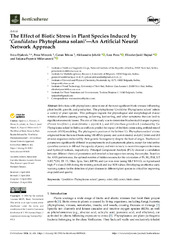Приказ основних података о документу
The Effect of Biotic Stress in Plant Species Induced by ‘Candidatus Phytoplasma solani’—An Artificial Neural Network Approach
| dc.creator | Đalović, Ivica | |
| dc.creator | Mitrović, Petar | |
| dc.creator | Trivan, Goran | |
| dc.creator | Jelušić, Aleksandra | |
| dc.creator | Pezo, Lato | |
| dc.creator | Janić Hajnal, Elizabet | |
| dc.creator | Popović Milovanović, Tatjana | |
| dc.date.accessioned | 2024-04-24T10:29:11Z | |
| dc.date.available | 2024-04-24T10:29:11Z | |
| dc.date.issued | 2024 | |
| dc.identifier.issn | 2311-7524 | |
| dc.identifier.uri | https://plantarum.izbis.bg.ac.rs/handle/123456789/1246 | |
| dc.description.abstract | Infections with phytoplasma present one of the most significant biotic stresses influencing plant health, growth, and production. The phytoplasma ‘Candidatus Phytoplasma solani’ infects a variety of plant species. This pathogen impacts the physiological and morphological characteristics of plants causing stunting, yellowing, leaf curling, and other symptoms that can lead to significant economic losses. The aim of this study was to determine biochemical changes in peony (Paeonia tenuifolia L.), mint (Mentha × piperita L.), and dill (Anethum graveolens L.) induced by ‘Ca. Phytoplasma solani’ in Serbia as well as to predict the impact of the biotic stress using artificial neural network (ANN) modeling. The phylogenetic position of the Serbian ‘Ca. Phytoplasma solani’ strains originated from the tested hosts using 16S rRNA (peony and carrot strains) and plsC (mint and dill strains) sequences indicated by their genetic homogeneity despite the host of origin. Biochemical parameters significantly differed in asymptomatic and symptomatic plants, except for total anthocyanidins contents in dill and the capacity of peony and mint extracts to neutralize superoxide anions and hydroxyl radicals, respectively. Principal Component Analysis (PCA) showed a correlation between different chemical parameters and revealed a clear separation among the samples. Based on the ANN performance, the optimal number of hidden neurons for the calculation of TS, RG, PAL, LP, NBT, •OH, TP, TT, Tflav, Tpro, Tant, DPPH, and Car was nine (using MLP 8-9-13), as it produced high r2 values (1.000 during the training period) and low SOS values. Developing an effective early warning system for the detection of plant diseases in different plant species is critical for improving crop yield and quality. | sr |
| dc.language.iso | en | sr |
| dc.publisher | MDPI Basel | sr |
| dc.relation | info:eu-repo/grantAgreement/MESTD/inst-2020/200010/RS// | sr |
| dc.relation | info:eu-repo/grantAgreement/MESTD/inst-2020/200032/RS// | sr |
| dc.relation | info:eu-repo/grantAgreement/MESTD/inst-2020/200053/RS// | sr |
| dc.relation | info:eu-repo/grantAgreement/MESTD/inst-2020/200051/RS// | sr |
| dc.rights | openAccess | sr |
| dc.rights.uri | https://creativecommons.org/licenses/by/4.0/ | |
| dc.source | Horticulturae | sr |
| dc.subject | ‘Candidatus Phytoplasma solani’; | sr |
| dc.subject | peony | sr |
| dc.subject | mint | sr |
| dc.subject | dill | sr |
| dc.subject | carrot | sr |
| dc.subject | biotic stress | sr |
| dc.title | The Effect of Biotic Stress in Plant Species Induced by ‘Candidatus Phytoplasma solani’—An Artificial Neural Network Approach | sr |
| dc.type | article | sr |
| dc.rights.license | BY | sr |
| dc.citation.issue | 5 | |
| dc.citation.spage | 426 | |
| dc.citation.volume | 10 | |
| dc.type.version | publishedVersion | sr |
| dc.identifier.doi | 10.3390/horticulturae10050426 | |
| dc.identifier.fulltext | http://plantarum.izbis.bg.ac.rs/bitstream/id/3847/horticulturae-10-00426.pdf |


